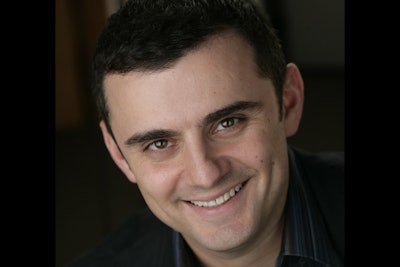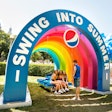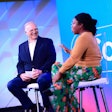
Gary Vaynerchuk was an early adopter in the world of Internet marketing. In 1997, he launched WineLibrary.com, an e-commerce site tied to his family’s New Jersey liquor store that helped increase sales from $3 million to $45 million by 2005. In 2006, he created an online video channel, Wine Library TV, which attracted as many as 100,000 views a day. Now Vaynerchuk is using his experience and knowledge to help companies such as G.E., PepsiCo, and the Brooklyn Nets manage their social media strategy through his company, VaynerMedia, which has grown from 25 to 250 people in the past 18 months.
Vaynerchuk will deliver the keynote address at Elevate, a one-day conference BizBash and Eventbrite will host on July 24 at the New York Law School. As a preview to his presentation, we spoke to Vaynerchuk to get his take on using social media for events and marketing. (More information on Elevate—including how to register—can be found here.)
You started using the Internet for marketing and engagement 16 years ago. What have you learned over the years?
The biggest thing I’ve learned along the way is that people hate change. Everything that has happened in the last six or seven years has been inevitable. But it’s been fascinating to me that we can even still have conversations about its validity or its metrics or its value. People still say things like "Oh this Facebook stuff really does matter." The overall journey has left me reminded that people tend to stick to tried and true, they don’t like change, and they lack the vision of where the world is going versus where the world is.
You made a similar comment at the recent Real Estate Expo, when you advised people to “be where the consumer will be in the future.” But how do brands and planners do that?
The future is actually the present. Vine has 13 million users as of the last month and will probably have 100 million by the fall. They are mostly 8- to 23-year-olds. But in three or four years that platform will be more mature. They will be 25- to 42-year-olds. So you don’t guess what the future will be, you fast follow. As soon as Vine or Snapchat or Pinterest or Instagram come out and get any bit of traction—they make their first appearance in The New York Times or The Wall Street Journal—or if you read TechCrunch or if you follow people that look like me, it’s very easy to stay on top of what’s starting to happen, jump in, and start playing with it. Because for every one that doesn’t become the next biggest thing, there’s one that will be. And those things really matter.
Is it easier to stand out on social platforms if you jump in early?
There are supply and demand issues that will occur. That’s the reason to start doing things on Vine or on Snapchat or on Pinterest. There’s a lane-grab early on that people leave on the table by not trying to innovate or take the most value out of a platform. On the flip side, I still believe that cream rises to the top. I do still believe if I just started today talking about my business thoughts and ideas, that I would still be successful. I don’t think it is completely predicated on being early. Quality is a very important factor here. For brands to stand out, they need to bring value, whether it’s great content, whether it’s information, whether it’s utility. Whatever it may be, quality really still does matter.
How do you define quality?
The public defines it for you. Plenty of people don’t think [Keeping Up With] the Kardashians is good, quality television. The problem is, when millions of people watch it, that means it is quality. It means there is a consumer for it. So I hope people don’t take quality in an academic or emotional way. Deciding what you think is quality and then applying your point of view as the end all be all to what’s going to happen is why a lot of people get into trouble and are wrong about where the world is going. You need to react to the reality. How many times have you heard, "Oh spending hours on Facebook is such a waste of time"? Why is it any different than watching TV for four hours? The answer is, television got accepted. We are looking at a revolution. So making a decision that something is a waste of time on a personal level and then allowing that to impact your business, that’s where people get into trouble.
You have a book coming out in November, Jab, Jab, Jab, Right Hook: How to Tell Your Story in a Noisy, Social World. Give us a preview of that.
It is completely predicated on this notion of storytelling. It addresses your question of how to stand out. How do you break through all the noise? I dissect Facebook, Twitter, Tumblr, and all these platforms and explain how storytelling has changed the world. How you need to figure out how to tell which story; the nuances of every platform; why a picture on Facebook is different than a picture on Pinterest; how to make a proper animated GIF for Tumblr. It’s a very heavy utility on how to be a successful storyteller to drive business results specifically for social networks.
How does engagement on social media impact engagement in the real world, for example at conferences, trade shows, and other face-to-face events?
Social media is a gateway drug to the real world. It scales much more than the real world does. You can sit in your room and talk on Twitter and Facebook and all these platforms for hours to thousands of people that live in places far, far away. You could never have those conversations with those individuals without the scale of what social media brings. Social media is just the plumbing for word of mouth in our society today. What excites me about that is that it leads and lends itself to bigger relationships. I was at a conference this morning and there were people that I’ve interacted with tons of times on Facebook and Twitter even though I’ve only spent 10 human minutes with them in my entire life. But today I spent 45 minutes with them because we already had a deeper relationship. So I view it as a gateway drug.
Do you have any specific tips for planners on using social media for their events?
It really depends on the event, and, for example, whether it’s a public event versus a closed event. But you can put out micro content—pictures, videos—from prior events [as an] innuendo to what kind of event it might be. You have to have a community on these [social] platforms first, which predicates the fact that you have to be building your relationships with people at all times, always for the moment when you go in for the kill. I’m doing a lot of things all the time giving value to people so that then when I am selling a book it just sells itself. Also, know what you are trying to accomplish and then respect the new platforms to tell what you are trying to accomplish on them in the proper way. If you are trying to get people to come to your show, there is a different way to do that in a blog than in a Facebook post than in a Pinterest post than in a Tumblr post than in an Instagram photo. Learn, put in the time, find the right people to figure that out. You win.
Do you think social media management needs to be a full-time job for brands and companies?
I think it is inevitable that it will be. But I can also respect why at this point in its life people are still half pregnant, so you have someone who is in PR or an intern doing it. That’s okay by me, because I understand social media is a marathon, not a sprint. So the return on investment takes a lot of time. It’s not practical for people to put a lot of money into it. But they should be mentally all-in even if executionally they are half pregnant.
Finally, it seems like often the conversation is about using social media to build buzz before an event, or to drive engagement during an event, but what about its role after an event?
There’s a real place for it. You just asked me what do you think about the thank-you card. That’s what you asked me. So you are either a person that believes in it and think it brings value—because it makes a deeper relationship or makes it more likely for you to do business together in the future—or you don’t think it’s worth your time. It’s as simple as that. That’s how I look at everything. It’s all happened before. This is nothing new. These are just new products. In the past, this was all done through the telephone and the written letter. There are new nuances when it’s this fast, so the upside and the value is even greater. That’s where I want people to wake up and smell the roses. The upside is tremendous for the people that are putting in the time and effort and have the skills to actually do this.



















